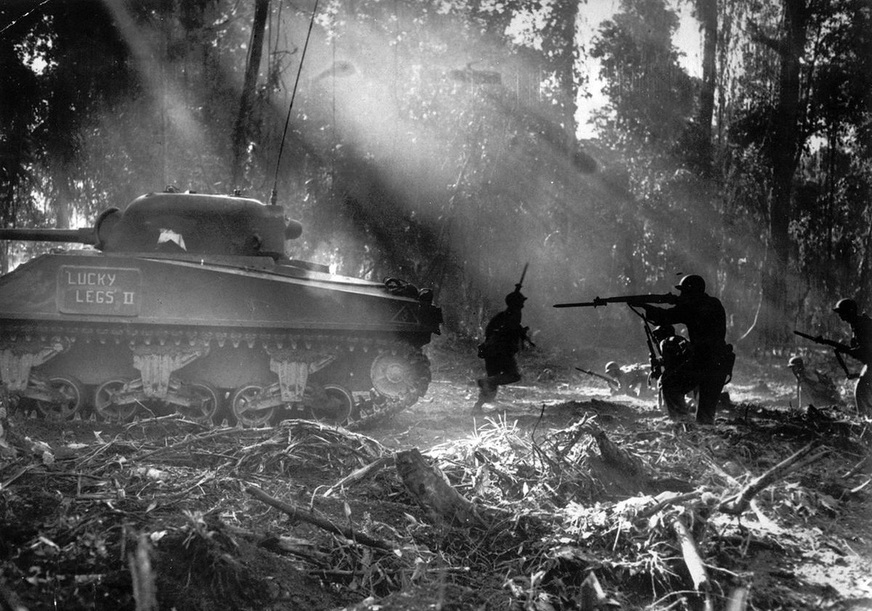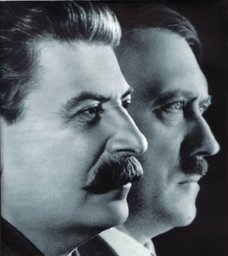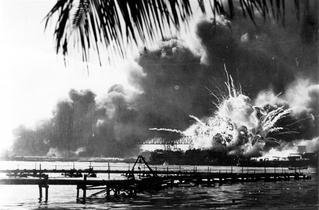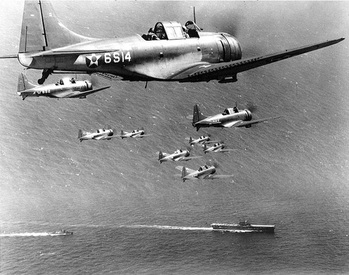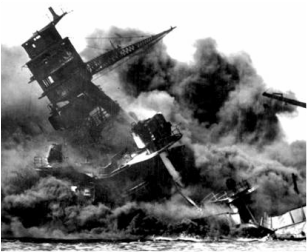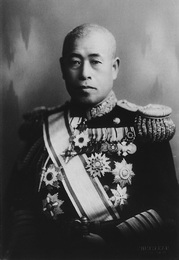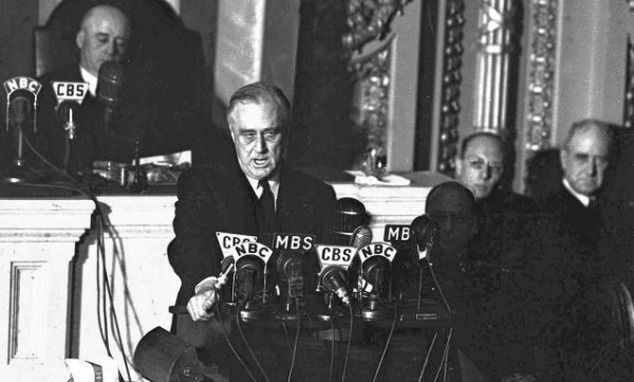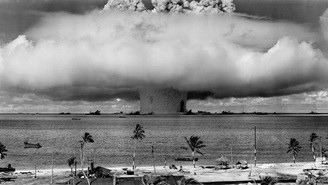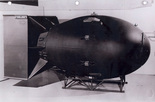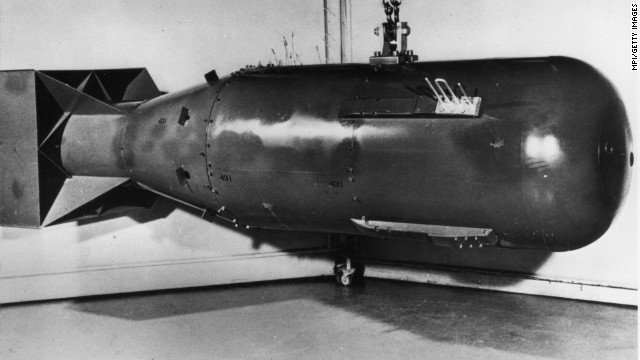FIGHTING IN WORLD WAR II
FAST TRACK LESSON
|
The Japanese lost 29 aircraft and 5 midget submarines in the attack. One Japanese soldier was taken prisoner and 129 Japanese soldiers were killed. Out of all the Japanese ships that participated in the attack on Pearl Harbor only one, the Ushio, survived until the end of the war. It was surrendered to the U.S.
Admiral Isoroku Yamamoto was the man who planned and organized the attack on Pearl Harbor for Japan. When he learned that his forces had not destroyed the U.S. aircraft carriers or completely destroyed the U.S. fleet, he said, “I fear we have awakened a sleeping giant.” Yamamoto feared that the United States with its great industrial power, would soon recover and fight back.
|
President Franklin D. Roosevelt was president of the United States when Japan attacked Pearl Harbor. The following excerpt is a portion of the speech that FDR gave to Congress on December 8, 1941 asking Congress to declare war on Japan.
|
Yesterday, December 7, 1941—a date which will live in infamy—the United States of America was suddenly and deliberately attacked by naval and air forces of the Empire of Japan.
The United States was at peace with that nation, ..... Indeed, one hour after Japanese air squadrons had commenced bombing in the American island of Oahu, the Japanese ambassador to the United States and his colleague delivered to our secretary of state a formal reply to a recent American message. While this reply stated that it seemed useless to continue the existing diplomatic negotiations, it contained no threat or hint of war or armed attack. ..... it obvious that the attack was deliberately planned many days or even weeks ago. During the intervening time the Japanese government has deliberately sought to deceive the United States by false statements and expressions of hope for continued peace. The attack yesterday on the Hawaiian Islands has caused severe damage to American naval and military forces. I regret to tell you that very many American lives have been lost. In addition, American ships have been reported torpedoed on the high seas between San Francisco and Honolulu. .... The facts of yesterday and today speak for themselves. The people of the United States have already formed their opinions and well understand the implications to the very life and safety of our nation. As commander in chief of the Army and Navy I have directed that all measures be taken for our defense. But always will our whole nation remember the character of the onslaught against us.... |
America - Arsenal of Democracy
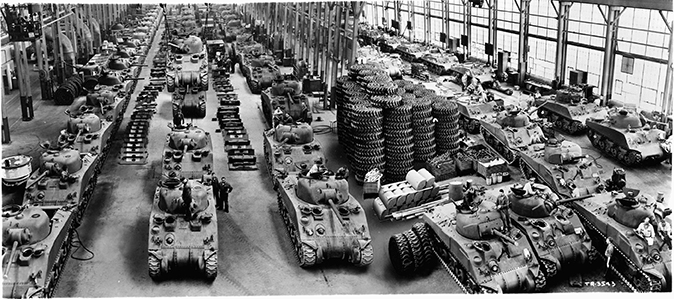
Despite the losses at Pearl Harbor, the industrial capability of the United States was quickly mobilized. The U.S. quickly increased the size of its army and began overhauling its factories to manufacture weapons, ammunition, ships, planes, tanks, and the other necessities of war. In addition to supplying its own military, the United States was able to ship these products to its allies in Britain and the Soviet Union who were desperately in need of them. The United States was the “arsenal of democracy,” supplying other countries as well as itself.
Fighting Back
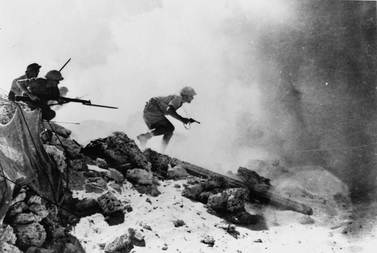
In the Middle East, Allied troops gained control of Iraq, Syria, Lebanon, and Iran. In the Battle of El Alamein in Egypt in 1942, they took command of Northern Africa. Allied troops invaded Italy, and Italy surrendered in 1943. In 1944 the Allies attacked German-held areas in Italy.
D-Day at Normandy
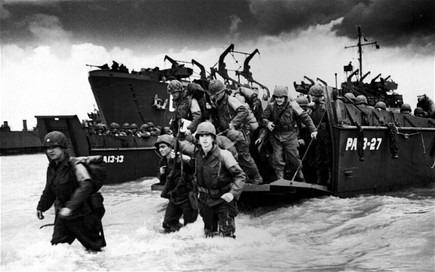
On June 6, 1944, or D-Day, the Allies launched the greatest amphibious assault (land and water) in history at Normandy on the coast of France. More than 2,700 ships and 175,000 men participated in the invasion of Europe. After bitter fighting, the Allied forces of England, the United States, and French Freedom Fighters finally broke through stiff German resistance in late July 1944, rolled eastward liberating Paris in August, and pushed on toward Germany. German troops stopped the Allied advance temporarily at the Ardennes Forest in Belgium, but in the Battle of the Bulge, American and Allied troops eventually won and moved on toward Germany.
Soviets Push Back Germany
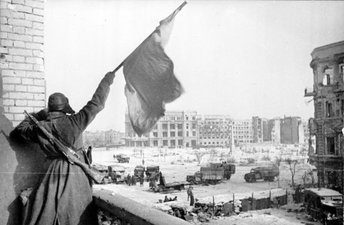
Soviet forces hammered German troops in the east. After the Soviet victory at the Battle of Stalingrad, their troops pushed steadily west. They won a massive tank battle at Kursk, forcing the Germans to retreat to save their remaining tanks. In January 1944, the Soviets ended a two-year German siege of Leningrad where over a million of their citizens had died. By 1944 the Soviets had forced German troops off its own territory and invaded Germany. Hitler committed suicide on April 30, 1945, and Germany surrendered unconditionally on May 7, 1945.
War in the Pacific
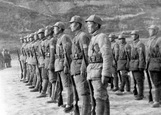
After Pearl Harbor, Japan launched a series of victorious assaults. They overran Thailand, Burma, Hong Kong, Malaya, Singapore, Indonesia, much of New Guinea, and the Philippines. They were within striking distance of Australia.
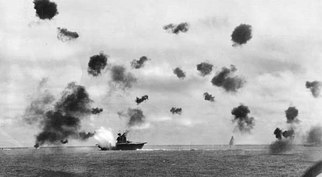
The United States was able to win two decisive victories in the Battle of Coral Sea in May 1942 and the crucial Battle of Midway in June 1942. This latter battle was probably the most important naval engagement in 500 years. It turned the tide of war for the U.S. and its allies. In a major series of battles, American troops and their allies retook the Gilbert, Marshall, and Mariana Islands, which became bases for launching air attacks against Japan itself. Allied forces invaded the Philippines and Burma.
The War Ends
|
On August 6, 1945, the United States dropped an atomic bomb on Hiroshima in Japan. Three days later they dropped a second bomb on Nagasaki. The effects of these bombs were devastating and caused enormous destruction and more than 100,000 casualties. On August 14, the Japanese surrendered, ending World War II.
|
ANSWER IT!

Step 3: Answer the questions about the fighting in World War II by clicking on the icon to the right. Use the reading to answer the questions. When you are done submit your answers.
MISSION ACCOMPLISHED!

You have completed the Fighting in World War II Fast Track Lesson.
